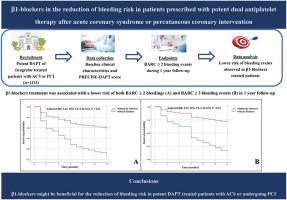Hellenic Journal of Cardiology ( IF 4.1 ) Pub Date : 2023-10-12 , DOI: 10.1016/j.hjc.2023.09.017 Shizhao Zhang 1 , Yangxun Wu 1 , Chao Lv 1 , Haiping Liu 1 , Yuyan Wang 1 , Lisha Dong 1 , Yuqi Liu 1 , Shengshu Wang 1 , Jianjun Jia 1 , Tong Yin 1

|
Background
β1-blockers could improve clinical outcomes in patients with coronary artery disease by lowering the heart rate, blood pressure, and myocardial contractility. Moreover, recent studies have suggested that β1-blockers may also have the potential to reduce bleeding risk.
Objectives
This study aimed to evaluate the association between β1-blockers and bleeding risk in the patients prescribed with potent dual antiplatelet therapy (DAPT) after acute coronary syndrome (ACS) or percutaneous coronary intervention (PCI).
Methods
Patients with ACS or undergoing PCI treated by DAPT of ticagrelor and aspirin were consecutively recruited. Follow-up for all eligible patients was conducted for 1 year. Major bleeding outcomes were defined as events that were type ≥2 based on the Bleeding Academic Research Consortium (BARC) criteria.
Results
A total of 1,113 eligible ticagrelor-treated patients were recruited. During the 1-year follow-up interval, 142 (12.6%) patients experienced BARC ≥2 bleedings including 23 patients (2.1%) suffering BARC ≥3 bleedings, with the most common site of bleeding located in the gastrointestinal tract. β1-blockers treatment was associated with a lower risk of BARC ≥2 bleedings (11.2% vs. 23.3%, adjusted HR: 0.42, 95% CI: 0.28-0.62, P < 0.01). Moreover, metoprolol (11.1% vs. 23.3%, adjusted HR: 0.56, 95% CI: 0.37-0.83, P < 0.01) and bisoprolol (11.3% vs. 23.3%, adjusted HR: 0.56, 95% CI: 0.33-0.96, P = 0.04) had similar effects on the reduction of bleeding risk.
Conclusion
β1-blockers might be beneficial for the reduction of bleeding risk in potent dual antiplatelet therapy patients with ACS or undergoing PCI.
中文翻译:

β1-受体阻滞剂可降低急性冠脉综合征或经皮冠状动脉介入治疗后接受强效双重抗血小板治疗的患者的出血风险
背景
β1-受体阻滞剂可以通过降低心率、血压和心肌收缩力来改善冠状动脉疾病患者的临床结果。此外,最近的研究表明,β1 受体阻滞剂也可能具有降低出血风险的潜力。
目标
本研究旨在评估急性冠状动脉综合征(ACS)或经皮冠状动脉介入治疗(PCI)后接受强效双重抗血小板治疗(DAPT)的患者中β1受体阻滞剂与出血风险之间的关联。
方法
连续招募接受替格瑞洛和阿司匹林DAPT治疗的ACS或接受PCI的患者。对所有符合条件的患者进行为期一年的随访。大出血结局定义为根据出血学术研究联盟 (BARC) 标准≥2 型的事件。
结果
总共招募了 1,113 名符合条件的接受替格瑞洛治疗的患者。在1年随访期间,142名(12.6%)患者出现BARC≥2次出血,其中23名患者(2.1%)出现BARC≥3次出血,最常见的出血部位位于胃肠道。β1 受体阻滞剂治疗与 BARC ≥2 次出血风险较低相关(11.2% vs. 23.3%,调整后 HR:0.42,95% CI:0.28-0.62,P < 0.01)。此外,美托洛尔(11.1% vs. 23.3%,调整后 HR:0.56,95% CI:0.37-0.83,P < 0.01)和比索洛尔(11.3% vs. 23.3%,调整后 HR:0.56,95% CI:0.33-0.96) ,P = 0.04)对降低出血风险有类似的作用。
结论
β1 受体阻滞剂可能有益于降低接受强效双重抗血小板治疗的 ACS 或接受 PCI 患者的出血风险。



























 京公网安备 11010802027423号
京公网安备 11010802027423号